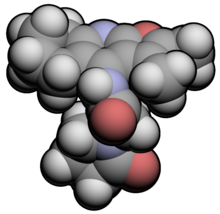Iron Game
Veteran
[h=1]Coluracetam[/h]
<caption style="font-size: 19.25px; font-weight: bold; padding: 0.2em;"> Coluracetam </caption><tbody>
</tbody>Coluracetam (INN) (code name BCI-540; formerly MKC-231) is a nootropic agent of the racetam family.[SUP][1][/SUP] It was initially developed and tested by the Mitsubishi Tanabe Pharma Corporation for Alzheimer's disease. After the drug failed to reach endpoints in its clinical trials it was in-licensed by BrainCells Inc for investigations into major depressive disorder(MDD), which was preceded by being awarded a "Qualifying Therapeutic Discovery Program Grant" by the state of California.[SUP][2][/SUP] Findings from phase IIa clinical trials have suggested that it would be a potential medication for comorbidMDD with generalized anxiety disorder (GAD).[SUP][3][/SUP]BrainCells Inc is currently[SUP][when?][/SUP] out-licensing the drug for this purpose.[SUP][4][/SUP][SUP][full citation needed][/SUP] It may also have potential use in prevention and treatment of ischemic retinopathy and retinal and optic nerve injury.[SUP][medical citation needed][/SUP]
Coluracetam has been shown to reverse the loss of choline acetyltransferase production in the medial septal nucleus of rats exposed to phencyclidine (PCP), and is considered a potential therapeutic drug for schizophrenia.[SUP][5][/SUP]
[h=2]Mechanism of action[edit][/h]Coluracetam enhances high-affinity cholineuptake (HACU),[SUP][6][/SUP] which is the rate-limiting step of acetylcholine (ACh) synthesis. Studies have shown coluracetam to improve learning impairment on a single oral dose given to rats which have been exposed to cholinergic neurotoxins. Subsequent studies have shown that it may induce long-lasting procognitive effects in cholinergic neurotoxin-treated rats by changing the choline transporter regulation system.[SUP][7][/SUP]

| |

| |
| Clinical data | |
|---|---|
| ATC code |
|
| Identifiers | |
IUPAC name[show] | |
| CAS Number |
|
| PubChem <abbr title="Compound ID" style="border-bottom: 0px; cursor: help;">CID</abbr> |
|
| ChemSpider |
|
| Chemical and physical data | |
| Formula | C[SUB]19[/SUB]H[SUB]23[/SUB]N[SUB]3[/SUB]O[SUB]3[/SUB] |
| Molar mass | 341.404 g/mol |
| 3D model (JSmol) |
|
SMILES[show] | |
InChI[show] |
<caption style="font-size: 19.25px; font-weight: bold; padding: 0.2em;"> Coluracetam </caption><tbody>
</tbody>
Coluracetam has been shown to reverse the loss of choline acetyltransferase production in the medial septal nucleus of rats exposed to phencyclidine (PCP), and is considered a potential therapeutic drug for schizophrenia.[SUP][5][/SUP]
[h=2]Mechanism of action[edit][/h]Coluracetam enhances high-affinity cholineuptake (HACU),[SUP][6][/SUP] which is the rate-limiting step of acetylcholine (ACh) synthesis. Studies have shown coluracetam to improve learning impairment on a single oral dose given to rats which have been exposed to cholinergic neurotoxins. Subsequent studies have shown that it may induce long-lasting procognitive effects in cholinergic neurotoxin-treated rats by changing the choline transporter regulation system.[SUP][7][/SUP]

